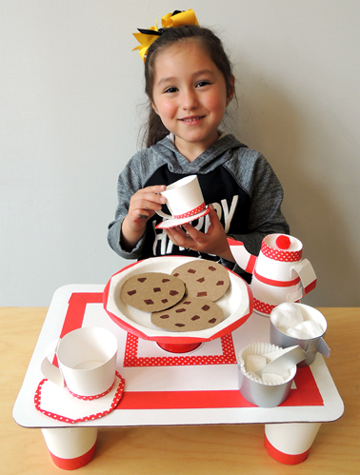
It might look like a proper tea table with matching teapot, cups, saucers, sugar bowl, creamer, and a platter of cookies. But beware! Your guests want those cookies something fierce, and aren’t afraid to get grabby in our fast-paced cookie snatching game! Video, of course, at the end of the post.
We read Tea Party Rules, written by Ame Dyckman, and illustrated by K.G. Campbell (Viking, 2013). A bear cub follows the delicious smell of cookies to a little girl’s tea party. Pretending to be the girl’s stuffed bear, the cub eagerly awaits the moment when he can devour the cookies. He’s got her completely fooled, but then the girl decides that her toy bear needs to follow the “Tea Party Rules.” In other words, he needs to be clean, neat, fancy, and dainty. Poor Cub is subjected to a bath, ribbons, perfume and a dress. But when it comes time for a lecture on dainty eating, he snaps. He attacks the cookies. When only one cookie remains, Cub stops. Suddenly, he realizes that he’s not only ruined the tea party, he’s made the girl very sad. So he gives the final cookie to her. Does she eat daintily? No she does not. She decides it’s time to play BEAR!
You’ll need:
- 9 – 10 paper cups
- 1 corrugated cardboard base (I used a 9.75″ x 13.75″ cake pad)
- A selection of patterned tape
- A selection of color masking tape
- 1 small paper plate (mine was 7″ in diameter)
- 1 spouts template, printed on 8.5″ x 11″ card stock
- Extra poster board for tea set handles, spouts, and sugar tongs
- 1 small pom-pom
- 2 circles of white poster board (approximately 3.5″ in diameter)
- 3 circles of tag board or brown poster board (approximately 3.5″ in diameter)
- 3 button magnets
- 1 rectangle of or brown poster board (approximately 2.5″ x 9.25″)
- 1 rectangle of white poster board (approximately 3.5″ x 9.25″)
- 2 jumbo paper clips (mine were 2″ long)
- Scissors and tape for construction
- Markers for decorating
- Hot glue
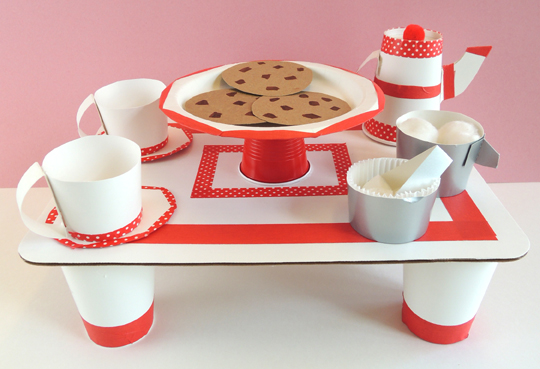 This project consists of 1) A tea set with cookies; and 2) A pair hand grabbers for the snatching game. The cookies have magnets hot glued to them, and the hand grabbers have paper clips taped to them. Thus, when the hand slaps down on the cookie, it picks it up!
This project consists of 1) A tea set with cookies; and 2) A pair hand grabbers for the snatching game. The cookies have magnets hot glued to them, and the hand grabbers have paper clips taped to them. Thus, when the hand slaps down on the cookie, it picks it up!
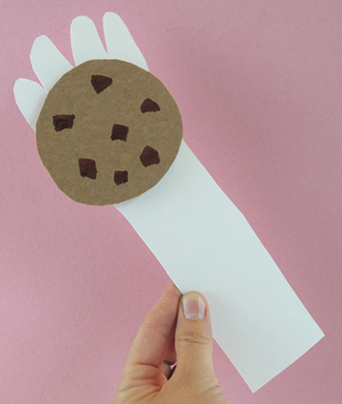 We’ll begin with the tea set. To make the table, hot glue 4 paper cups to the bottom of a corrugated cardboard base. The cookie platter is a flipped-over cup hot glued to a small paper plate. You don’t want the cookie platter to be too tall, so you can either cut a full size paper cup down to 2.25″ inches, or use a shorter cup (we used 3.5oz plastic drinking cups from Target). Decorate the platter and table with patterned tape, color masking tape, and/or markers. Then hot glue the platter firmly to the top of the table.
We’ll begin with the tea set. To make the table, hot glue 4 paper cups to the bottom of a corrugated cardboard base. The cookie platter is a flipped-over cup hot glued to a small paper plate. You don’t want the cookie platter to be too tall, so you can either cut a full size paper cup down to 2.25″ inches, or use a shorter cup (we used 3.5oz plastic drinking cups from Target). Decorate the platter and table with patterned tape, color masking tape, and/or markers. Then hot glue the platter firmly to the top of the table.
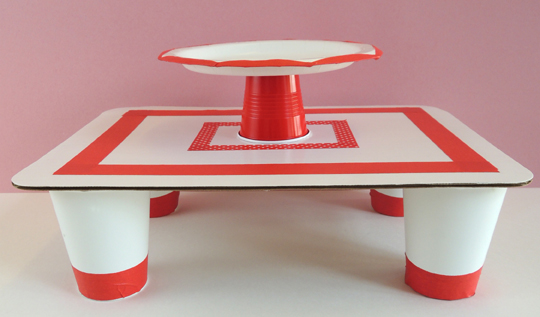 To make the teapot, flip a paper cup over, then tape (or hot glue) a poster board handle to one side. Cut the spout from the template and trace it onto white poster board. Fold the tea pot spout in half (the fold is marked with a solid black line on the template). Next, fold the spout’s tabs outward (the tabs are marked with dotted lines on the template). Attach the tabs to the tea pot with tape (or hot glue). Finish by hot gluing a small pom-pom to the top of the tea pot.
To make the teapot, flip a paper cup over, then tape (or hot glue) a poster board handle to one side. Cut the spout from the template and trace it onto white poster board. Fold the tea pot spout in half (the fold is marked with a solid black line on the template). Next, fold the spout’s tabs outward (the tabs are marked with dotted lines on the template). Attach the tabs to the tea pot with tape (or hot glue). Finish by hot gluing a small pom-pom to the top of the tea pot.
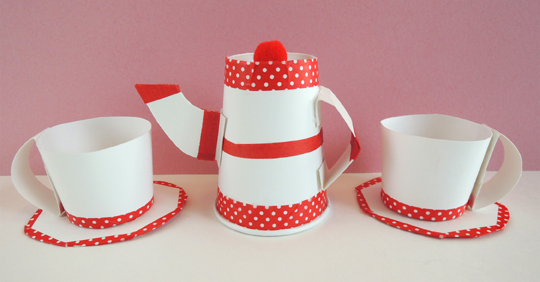 To make tea cups, cut 2 paper cups down to 2″. Use tape (or hot glue) to attach a white poster board handle to the side of each cup. Then place the cups on a white poster board “saucers.” Decorate the teapot, cups, and saucers with patterned tape, color masking tape, and/or markers.
To make tea cups, cut 2 paper cups down to 2″. Use tape (or hot glue) to attach a white poster board handle to the side of each cup. Then place the cups on a white poster board “saucers.” Decorate the teapot, cups, and saucers with patterned tape, color masking tape, and/or markers.
Next up – the sugar bowl and creamer. To make the sugar bowl, cut a paper cup down to 1.5″. Drop a paper baking cup inside for extra flair. To make tongs, fold a narrow strip of poster board in half. Those cute little sugar cubes? Foam packing peanuts, cut in half.
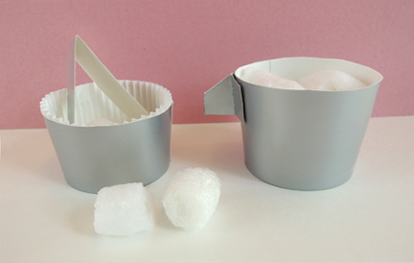 The creamer is a paper cup cut down to 2″. Cut the creamer spout from the template, and trace it into poster board. Fold the spout in half (the fold is marked with a solid black line on the template). Next, fold the spout’s tabs outward (the tabs are marked with dotted lines on the template). Attach the tabs to the cup with tape (or hot glue). We filled the creamer with white cotton ball “cream.”
The creamer is a paper cup cut down to 2″. Cut the creamer spout from the template, and trace it into poster board. Fold the spout in half (the fold is marked with a solid black line on the template). Next, fold the spout’s tabs outward (the tabs are marked with dotted lines on the template). Attach the tabs to the cup with tape (or hot glue). We filled the creamer with white cotton ball “cream.”
Finally…the cookies. These are circles of tagboard (or poster board) decorated with markers. We made 3 cookies per kid. Hot glue a button magnet to the back of each cookie.
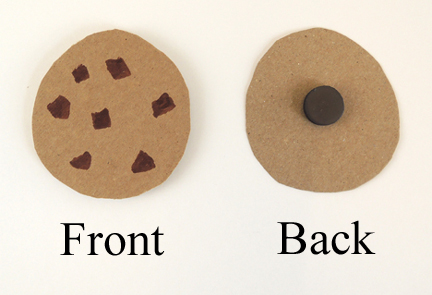
Now for the game! We had 2 hand grabbers – a bear paw and a fancy white glove. To make the bear’s paw, round one end of a 2.5″ x 9.25″ strip of tag board (or brown poster board). To make the glove, cut a hand in one end of a 3.5″ x 9.25″ strip of white poster board. Tape a jumbo paperclip across the palms of both grabbers.
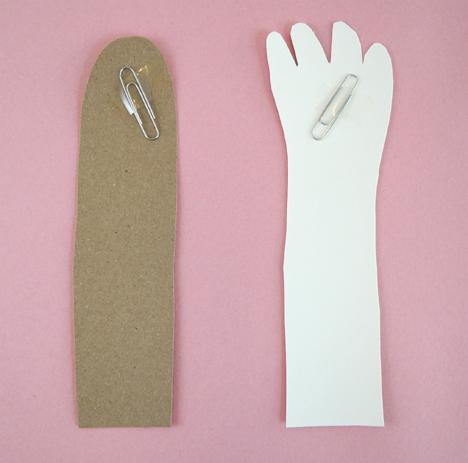 Ready to play? Have 2 kids select a grabber and sit down at the table. On “Go!” each kid must use his/her grabber to quickly remove cookies from the platter. The kid who grabs the most cookies, wins!
Ready to play? Have 2 kids select a grabber and sit down at the table. On “Go!” each kid must use his/her grabber to quickly remove cookies from the platter. The kid who grabs the most cookies, wins!

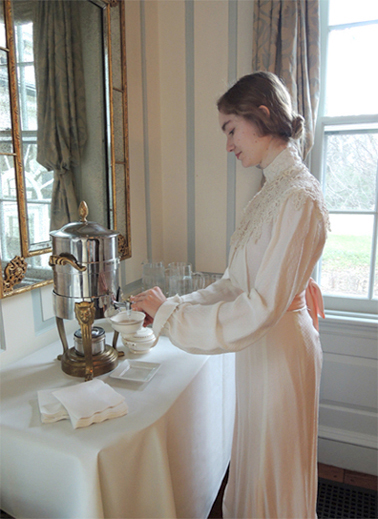 You had a sneak peek
You had a sneak peek 
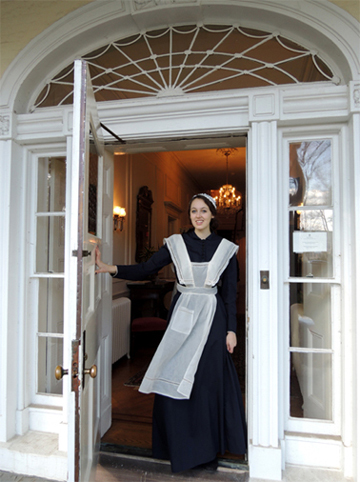 Upon arrival, the kids were greeted by our “maidservant” (otherwise known as Anna, a sophomore at Princeton). Anna stayed in character the entire time. Let me tell you, she does an extremely authentic curtsy and fantastically demure “Yes ma’am.” She shares about her experience
Upon arrival, the kids were greeted by our “maidservant” (otherwise known as Anna, a sophomore at Princeton). Anna stayed in character the entire time. Let me tell you, she does an extremely authentic curtsy and fantastically demure “Yes ma’am.” She shares about her experience  When everyone had arrived, I was officially announced by Anna. I sashayed into the room, greeted everyone, and proceeded to do a 15 minute PowerPoint presentation on the history of tea in England.
When everyone had arrived, I was officially announced by Anna. I sashayed into the room, greeted everyone, and proceeded to do a 15 minute PowerPoint presentation on the history of tea in England.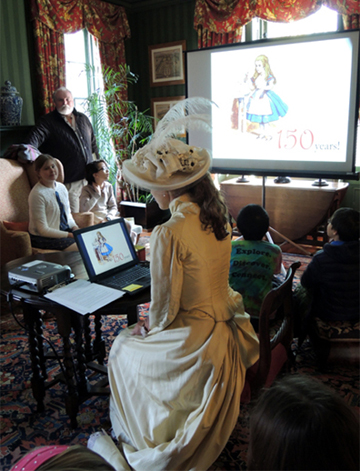 The historical content and connections for this program were quite extensive, and this post is already going to be rather long. So I’m going to describe the historical content in very broad brushstrokes. At the program, kids learned how tea was initially an expensive import available only to the upper class. It was also heavily taxed (sometimes over 100%). This resulted in a roaring trade in smuggled and adulterated tea. However, as tea became more affordable, it was enjoyed by all the citizens of England.
The historical content and connections for this program were quite extensive, and this post is already going to be rather long. So I’m going to describe the historical content in very broad brushstrokes. At the program, kids learned how tea was initially an expensive import available only to the upper class. It was also heavily taxed (sometimes over 100%). This resulted in a roaring trade in smuggled and adulterated tea. However, as tea became more affordable, it was enjoyed by all the citizens of England.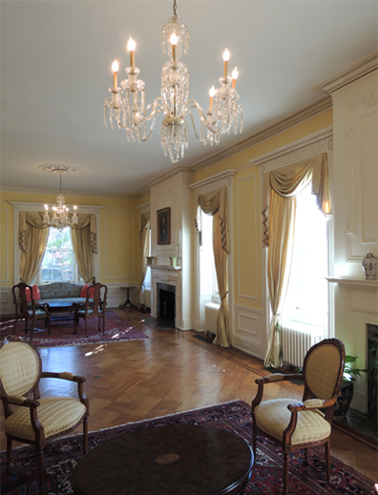 To the dining room where our splendid tea table was laid out!
To the dining room where our splendid tea table was laid out! Waiting at each chair was a unique teacup and saucer. The kids got to take home these cups and saucers as mementos. They were so excited.
Waiting at each chair was a unique teacup and saucer. The kids got to take home these cups and saucers as mementos. They were so excited.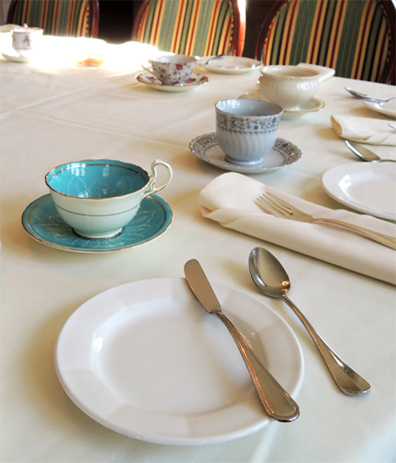 The take-home teacup was something I really, really wanted to do when I first conceptualized this program. So I sent a request through our library’s
The take-home teacup was something I really, really wanted to do when I first conceptualized this program. So I sent a request through our library’s 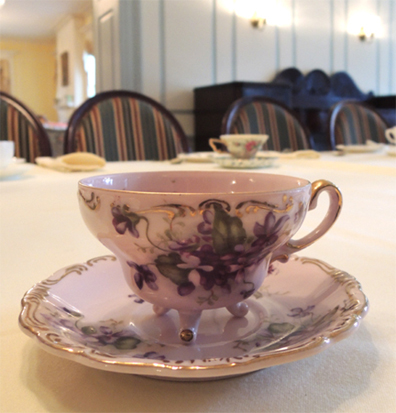 I also stopped by Nearly New, a local thrift store/consignment shop. They completely hooked me up with some delightful cups and saucers.
I also stopped by Nearly New, a local thrift store/consignment shop. They completely hooked me up with some delightful cups and saucers.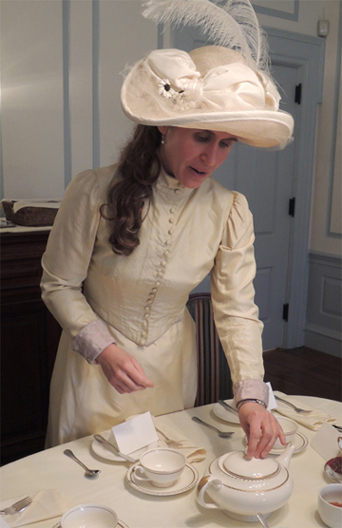 I couldn’t resist demonstrating tea pods as well. Have you seen these things? They are dried herbal pods you drop into hot water, and they “bloom” as they steep in the hot water. I first spotted one in Sophia Coppola’s movie Marie Antoinette. As luck would have it, Infini-T, our local tea shop, had them!
I couldn’t resist demonstrating tea pods as well. Have you seen these things? They are dried herbal pods you drop into hot water, and they “bloom” as they steep in the hot water. I first spotted one in Sophia Coppola’s movie Marie Antoinette. As luck would have it, Infini-T, our local tea shop, had them!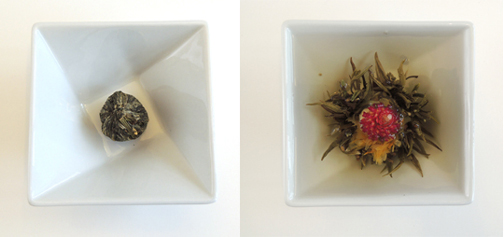
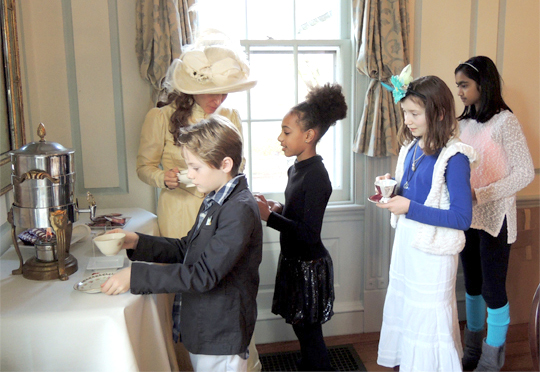 I was stationed next to the urn, offering milk and sugar. I can’t resist sharing this little history fact…way back when, sugar came in big cones you had to break apart with a special tool called sugar nippers. This resulted in irregular lumps of sugar. Hence the question “one lump or two?”
I was stationed next to the urn, offering milk and sugar. I can’t resist sharing this little history fact…way back when, sugar came in big cones you had to break apart with a special tool called sugar nippers. This resulted in irregular lumps of sugar. Hence the question “one lump or two?”
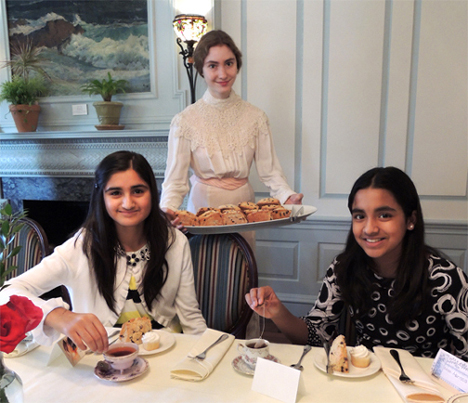
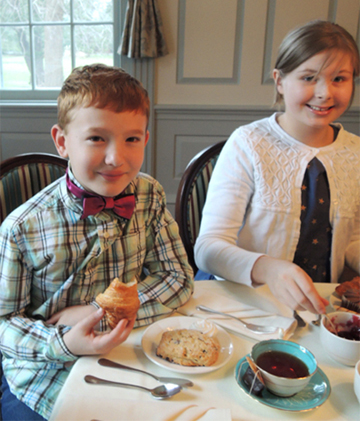
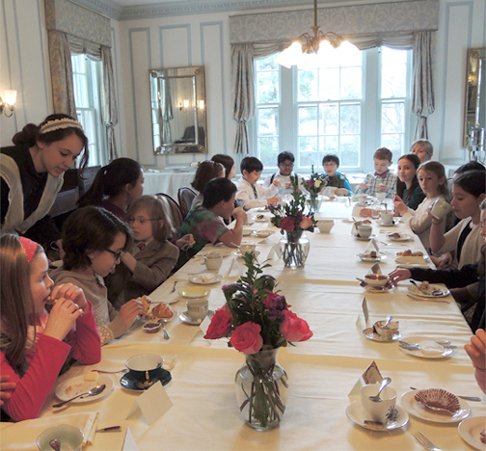
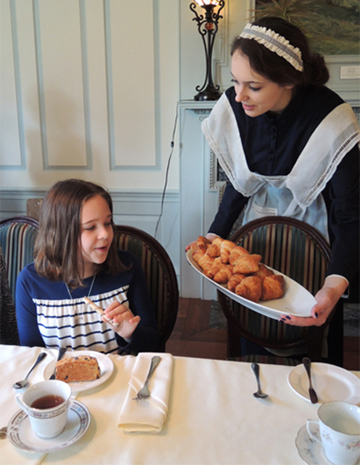
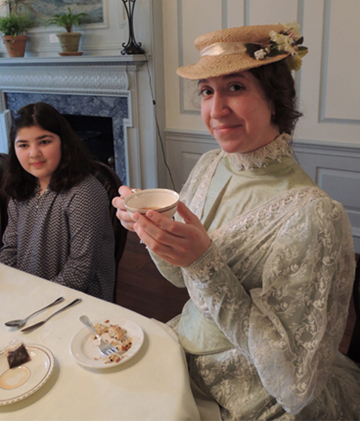
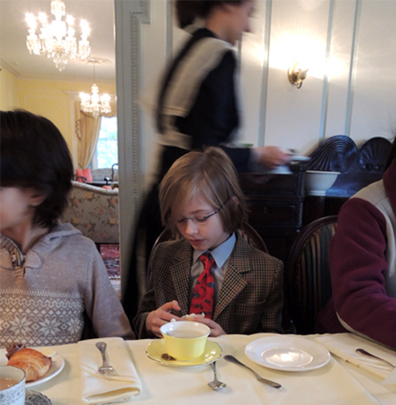
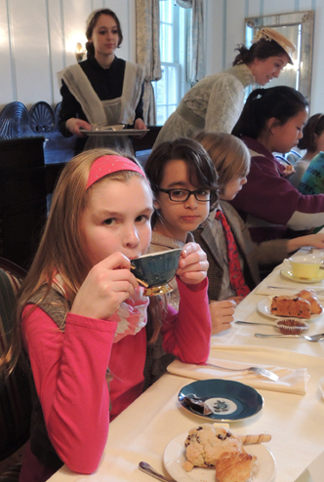
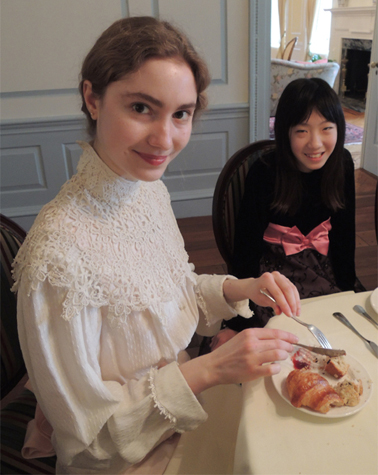 Having coached the kids on Victorian etiquette earlier in the program, I am happy to report that our young ladies and gentleman did very well indeed. Napkins were on laps, voices were not raised. We conversed very genially about their activities, interests, holiday doings, and travel adventures.
Having coached the kids on Victorian etiquette earlier in the program, I am happy to report that our young ladies and gentleman did very well indeed. Napkins were on laps, voices were not raised. We conversed very genially about their activities, interests, holiday doings, and travel adventures.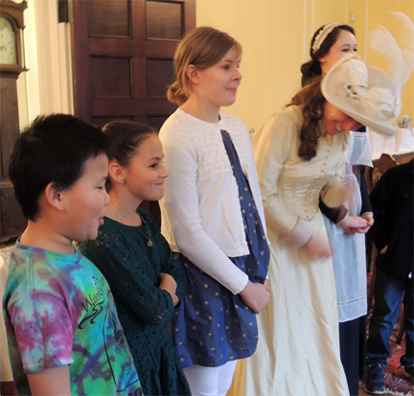 To play “Hunt the Thimble,” have everyone leave the room except for one person. That person must hide a thimble somewhere in the room (however, it must be in plain view and not hidden behind anything). The players reenter the room and silently begin searching. If you spot the thimble, you immediately sit on the floor. The last person standing must pay a forfeit.
To play “Hunt the Thimble,” have everyone leave the room except for one person. That person must hide a thimble somewhere in the room (however, it must be in plain view and not hidden behind anything). The players reenter the room and silently begin searching. If you spot the thimble, you immediately sit on the floor. The last person standing must pay a forfeit. And now, for the crowning glory of the program. Joani, who is in Glee Club, agreed to research and perform some popular period music pieces. She sang two, including “How Doth the Little Crocodile.” The song is, of course, the poem from Alice’s Adventures in Wonderland set to music. It’s from a rare 1872 Alice in Wonderland songbook from our special collections.
And now, for the crowning glory of the program. Joani, who is in Glee Club, agreed to research and perform some popular period music pieces. She sang two, including “How Doth the Little Crocodile.” The song is, of course, the poem from Alice’s Adventures in Wonderland set to music. It’s from a rare 1872 Alice in Wonderland songbook from our special collections. We asked these kids to sit and look “proper.”
We asked these kids to sit and look “proper.”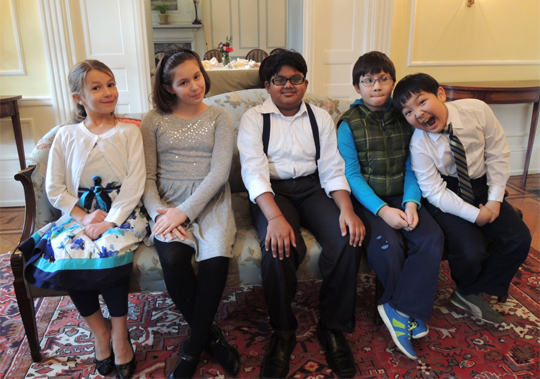 And check out the breeches on the young gentleman! I do believe those are modified baseball pants. That, my friends, is innovation.
And check out the breeches on the young gentleman! I do believe those are modified baseball pants. That, my friends, is innovation. But this “dress up” took the Wonderland cake. Behold the queen of hearts!
But this “dress up” took the Wonderland cake. Behold the queen of hearts!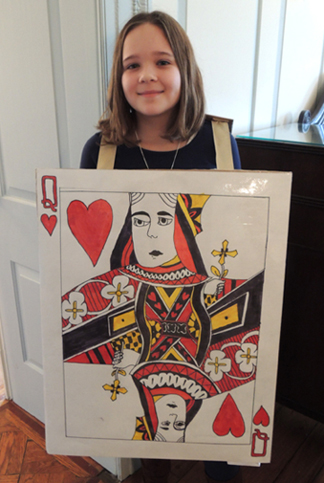 So how did the Victorian tea program go over? Amazingly well. Astonishingly well. We had a jolly good time I tell you! And while I loved the setting, the teacups, the costumes, and the cupcakes, the best part for me was how much history was packed in with the fun. Honestly, I don’t think any of them will ever look at a cup of tea in the same way again.
So how did the Victorian tea program go over? Amazingly well. Astonishingly well. We had a jolly good time I tell you! And while I loved the setting, the teacups, the costumes, and the cupcakes, the best part for me was how much history was packed in with the fun. Honestly, I don’t think any of them will ever look at a cup of tea in the same way again.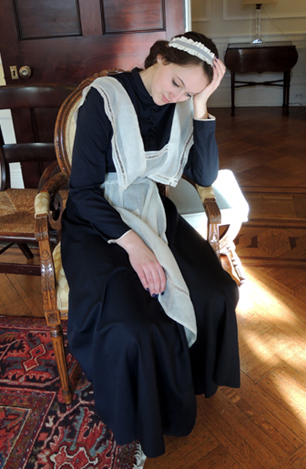
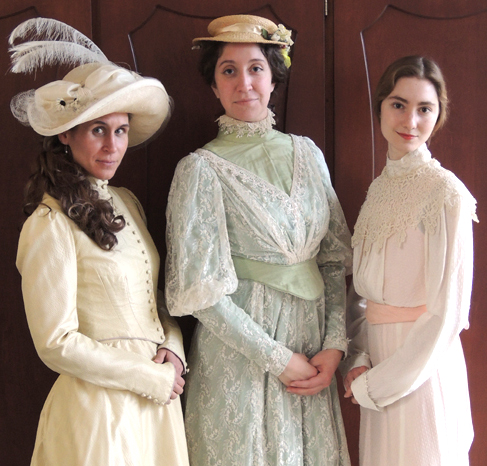 Very shortly, my library will be hosting a Victorian Tea
Very shortly, my library will be hosting a Victorian Tea  First up is Anna, who is a sophomore at Princeton University. She gamely stepped up to play our maid. Just in case you think we were being snobby and excluding Anna from the group shot that started this post – take heart! Anna’s photo shoot was in the afternoon, when she arrived for her library shift. The rest of the ladies were photographed in the morning. No Victorian class system at work here, no sir.
First up is Anna, who is a sophomore at Princeton University. She gamely stepped up to play our maid. Just in case you think we were being snobby and excluding Anna from the group shot that started this post – take heart! Anna’s photo shoot was in the afternoon, when she arrived for her library shift. The rest of the ladies were photographed in the morning. No Victorian class system at work here, no sir.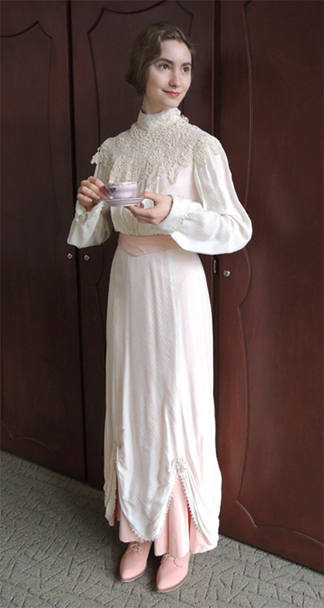 This is Joani, a junior at Princeton University. You might remember her from some previous posts (here she is as a
This is Joani, a junior at Princeton University. You might remember her from some previous posts (here she is as a 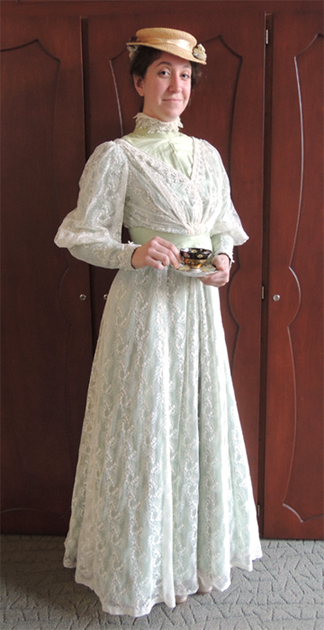 Our very own Miss Marissa will be keeping it real in scores of lace. Have you ever seen someone rock a straw hat so well? No, I think not.
Our very own Miss Marissa will be keeping it real in scores of lace. Have you ever seen someone rock a straw hat so well? No, I think not.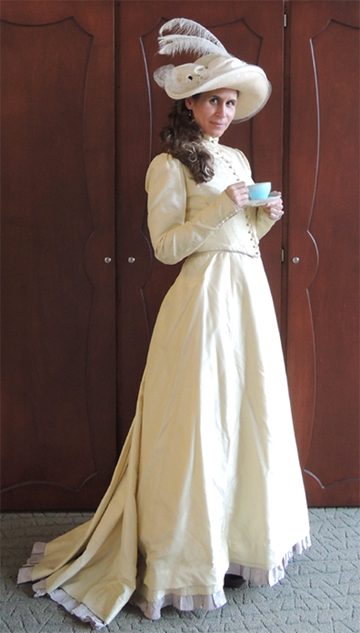 Finally, there’s me. I’ll be playing the matron of the house. Which means I needed a really, really, really big hat. There’s actually an interesting story to the hat. It was designed by Rodney Gordon, who did all the hats for the 1974 film version of The Great Gatsby with Mia Farrow and Robert Redford.
Finally, there’s me. I’ll be playing the matron of the house. Which means I needed a really, really, really big hat. There’s actually an interesting story to the hat. It was designed by Rodney Gordon, who did all the hats for the 1974 film version of The Great Gatsby with Mia Farrow and Robert Redford.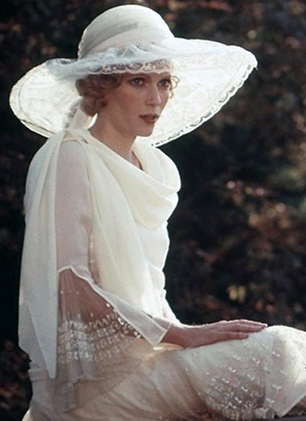 Image originally resides on
Image originally resides on